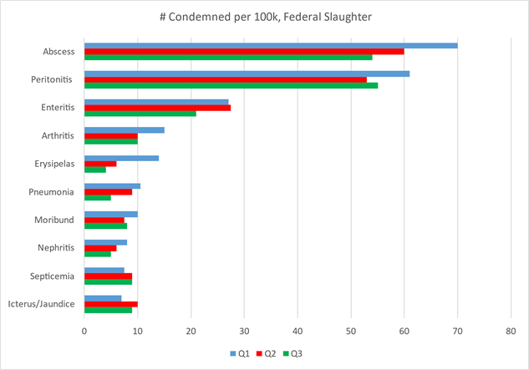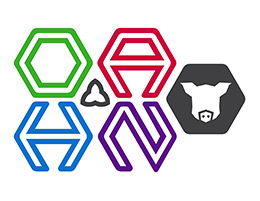Ontario Animal Health Network (OAHN) Swine Network Quarterly Producer/Industry Report
CAP Funding for Ontario’s Pork Sector
The governments of Canada and Ontario are investing nearly $3 million in three new initiatives as part of a coordinated effort to enhance biosecurity and support the provincial pork sector’s African swine fever (ASF) prevention and emergency preparedness efforts.
Starting November 5, 2021, a new targeted intake under the Canadian Agricultural Partnership (the Partnership) will provide funding to Ontario pork producers, processors and other agri-businesses to support their training, education and planning, as well as for supply and infrastructure investments and modifications needed to strengthen swine-related operations, support industry businesses, and protect the herds and livelihoods of Ontario pork producers.
For more information, click here: https://onswine.wordpress.com/2021/10/20/cap-funding-for-ontarios-pork-sector/
Phasing out of Eurasian Wild Boar in Ontario, and the Eurasian Wild Boar Transition Program
In Ontario, a small number of Eurasian wild boars have been imported and raised as alternative livestock on farms for meat. Eurasian wild boar and their hybrids play a greater role in the establishment and spread of wild pigs relative to domesticated breeds (for example, breeds of Sus scrofa domesticus). To protect Ontario’s natural environment and domestic pig industry, Ontario has introduced new directions to phase Eurasian wild boar and their hybrids out of the province by 2024.
For more information, click here: https://onswine.wordpress.com/2021/11/02/phasing-out-of-eurasian-wild-boar-in-ontario-and-the-eurasian-wild-boar-transition-program/
Condemnation Corner
Federal Slaughter Statistic Summary (Q3 Aggregate)
Dr. Christine Pelland reported the following:
Carcass Condemnations
- Total number of hogs slaughtered in Q3 2021 = 1,028569 with 1,927 carcasses condemned.
- Percent of carcasses condemned in Q3 2021 = 0.19% compared to Q1 2021 = 0.24% and Q2 2021 = 0.21%
- Abscesses, Peritonitis and Enteritis continue to be the 3 most common reasons for carcass condemnations.
Comment: Erysipelas appears to be following seasonal patterns identified in 2019 and 2020 with Q4 and Q1 showing highest number of condemns and Q2 and Q3 the lowest in each year. We will see if this pattern continues with a seasonal increase in Q4 2021.
Trim Demerit Condemnations
- Total number of carcasses that were subject to trim loss in Q3 2021 = 27,445 hogs
- Total weight of trim in Q1 2021 = 142,609 kg with an average trim weight of 5.2 Kg / animal trimmed
- Total number of carcasses that were subject to trim loss due to abscess in Q3 2021 = 15,098 carcasses with a total trim weight of 99,549 kg and an average trim weight of 6.6 Kg / animal trimmed.
The condemnation category of “abscess” encompasses a broad range of tissues that can be affected. There are many causes of abscesses. Some abscesses may require that pigs are euthanized on the farm, eg. large navel abscesses or joint abscesses causing significant pain and inhibiting locomotion. Other abscesses may not result in condemnation but result in trimming of the affected area. Abscesses exist in different sizes and locations. Condemnations can occur due to small abscesses in the lymph nodes of the neck or intestines that can be caused by M. paratuberculosis. Abscesses in other lymph nodes or tissues may be the result of infection due to fighting, castration wounds, ear necrosis, tail biting, dirty needles, or contaminated medicine bottles that are not stored properly after opening. Sometimes the abscess category can be used when no other specific category exists for an unexpected problem. In one case the problem was related to over-weight carcasses resulting from plant closures due to the pandemic. The carcasses were so long that the heads were “dragging on the floor” and they had to condemn the heads and needed a category for the condemnations. They happened to choose abscess. The point is that the devil is in the details. In order to solve a problem with excess condemnations it is often necessary to gather additional information that can help to focus the efforts to remedy the problem.
On an individual farm basis then, it is important to determine what “type” of abscesses the particular farm is dealing with. There is no easy way to go back and determine where the abscesses were located, eg. around a joint, internal or peripheral lymph nodes, navel, intra-muscular, etc. from the reports from most plants. You may however be able to make arrangements to have your herd veterinarian visit the plant when your hogs are being inspected. Sometimes the plant staff can collect that type of information and pass it on to the producer and veterinarian. This more detailed information can be more helpful to producers and their veterinarians in identifying potential sources of the problem so that a plan can be developed to address the problem. In most cases the processing plant staff is just as motivated to help correct the problem. If trim or condemnations are a problem in your herd, ask your herd veterinarian how they would suggest approaching the problem.
Comment: Trim frequency and total weight of trim lost (kg) due to abscess continues to be the most significant cause of trim loss. When coupled with total carcass condemnations due to abscess this constitutes a significant loss to the pork sector.

Ontario Provincial Slaughter Statistic Summary
Dr. Christine Pelland reported there were no significant changes in the provincial statistics.
OAHN Swine Small Holder Project Update
There was one additional small holder post mortem case in the past quarter. That brings us up to 24 cases in this project. The project has been extended to the end of March 2022 and the objective is to try and get some additional submissions.
The most recent case in Q3 was an abortion case with fetal vasculitis. The final diagnosis remains open and work continues to define the etiology. The good news is that there have been no further cases of abortion in this small herd and this may have been a “one off” case.
Disease Discussion
PORCINE EPIDEMIC DIARRHEA (PEDV) / PORCINE DELTACORONAVIRUS (PDCoV)
Jessica Fox, Swine Health Ontario Manager, reported that all previous cases that were reported have been resolved. There have been no PDCoV cases since Jan. 15, 2021. The PED and PDCoV Tracking map is available at the Swine Health Ontario website and shows current and annual cases by county. http://www.swinehealthontario.ca/Disease-Information/PED-PDCoV-Tracking-Map
INFLUENZA A (IAV)
Practitioners shifted their frequency rating for IAV with 38% ranking IAV as common and 62% as very common. This an increase after a quieter Q2 report. Thirty % of practitioners indicated that IAV activity had increased in Q3. Several practitioners commented on seeing many cases in finisher barns. Some of these cases were clinically “severe”. At least one practitioner commented that they are not necessarily submitting diagnostic samples and are basing the diagnosis on clinical signs.
AHL data included the following genotypes identified in 24 submissions in Q3 2021: Subtype H1N1 classical = 1 total with 1 alpha, 0 beta, 0 gamma. Pandemic H1N1= 0. subtype H3N2 = 14, subtype H1N2 = 9. Gallant Laboratories Ontario data included the following genotypes identified in Q3 2021: Subtype H1N1 = 0, subtype H3N2 = 0, subtype H1N2 = 1.
PORCINE CIRCOVIRUS 3 (PCV3)
There was a question added to the Q2 clinical impressions survey asking “In how many herds over the last 12 months have you diagnosed disease due to PCV3?” 100% of practitioners that answered the survey indicated that they had not made a diagnosis of clinical PCV3 in the last 12 months. One practitioner respondent in the Q3 survey commented that there should be ongoing discussion about the role of PCV3 in sow herds. They reported PCR-positive findings with histological lesions of
myocarditis and ISH-positive results in 2 farms on stillborn pigs. The significance of finding
viremia in sick vs healthy sows is uncertain but it seems like there is more viremia in sick versus healthy sows. Based on our PCV3 survey in Q2 we are recognizing that the frequency of PCV3 related cases in Ontario is still quite low but based on this comment probably not zero.
How can producers engage in OAHN?
- Read our quarterly producer reports and let us know what you think!
- Discuss the material included in these reports with you herd veterinarian and other swine producers. Help us spread the word!
What to do if you see feral pigs in Ontario…
- OMAFRA is working with the Ministry of Natural Resources & Forestry (MNRF) to put together a wild swine strategy for Ontario. The first step will be to try to identify wild swine within Ontario.
- The MNRF has set up a page on iNaturalist at: www.inaturalist. org/projects/ontariowild-pig-reporting for residents to document any possible wild pigs in Ontario. Sighting information can also be emailed to MNRFSpeciesConservationPolicyBranch@ontario.ca.


